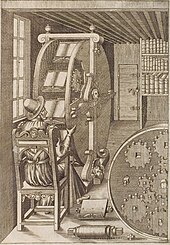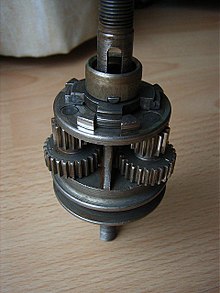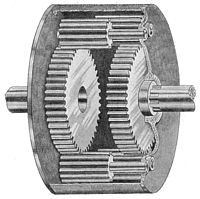An epicyclic gear train consists of two gears mounted so that the center of one gear revolves around the center of the other. A carrier connects the centers of the two gears and rotates to carry one gear, called the planet gear, around the other, called the sun gear. The planet and sun gears mesh so that their pitch circles roll without slip. A point on the pitch circle of the planet gear traces an epicycloid curve.
An epicyclic gear train can be assembled so the planet gear rolls on the inside of the pitch circle of the sun gear, which is then called an annular gear. In this case, the curve traced by a point on the pitch circle of the planet is a hypocycloid.
The combination of epicycle gear trains with a planet engaging both a sun gear and an annular gear is called a planetary gear train.[1][2]

This planetary gear train consists of a sun gear (yellow), planet gears (blue) supported by the carrier (green) and an annular gear (pink). The red marks show the relative displacement of the sun gear and carrier, when the carrier is rotated 45° clockwise and the annular gear is held fixed.
Overview[edit]
Epicyclic gearing or planetary gearing is a gear system consisting of one or more outer gears, or planet gears, revolving about a central, or sun gear. Typically, the planet gears are mounted on a movable arm or carrier which itself may rotate relative to the sun gear. Epicyclic gearing systems also incorporate the use of an outer ring gear or annulus, which meshes with the planet gears. Planetary gears (or epicyclic gears) are typically classified as simple and compound planetary gears. Simple planetary gears have one sun, one ring, one carrier, and one planet set. Compound planetary gears involve one or more of the following three types of structures: meshed-planet (there are at least two more planets in mesh with each other in each planet train), stepped-planet (there exists a shaft connection between two planets in each planet train), and multi-stage structures (the system contains two or more planet sets). Compared to simple planetary gears, compound planetary gears have the advantages of larger reduction ratio, higher torque-to-weight ratio, and more flexible configurations.
The axes of all gears are usually parallel, but for special cases like pencil sharpeners they can be placed at an angle, introducing elements of bevel gear (see below). Further, the sun, planet carrier and annulus axes are usually coaxial.

Bookwheel, from Agostino Ramelli's Le diverse et artifiose machine, 1588
History[edit]
In the 2nd-century AD treatise Almagest, Ptolemy used rotating deferent and epicycles that form epicyclic gear trains to predict the motions of the planets. Accurate predictions of the movement of the Sun, Moon and the five planets, Mercury, Venus, Mars, Jupiter and Saturn, across the sky assumed that each followed a trajectory traced by a point on the planet gear of an epicyclic gear train. This curve is called anepitrochoid.
Richard of Wallingford, an English abbot of St Albans monastery is credited for reinventing epicyclic gearing for an astronomical clock in the 14th century.[3]
In 1588, Italian military engineer Agostino Ramelli invented the bookwheel, a vertically-revolving bookstand containing epicyclic gearing with two levels of planetary gears to maintain proper orientation of the books.[4][3]
Gear ratio[edit]

In this example, the carrier (green) is held stationary while the sun gear (yellow) is used as input. The planet gears (blue) turn in a ratio determined by the number of teeth in each gear. Here, the ratio is −24/16, or −3/2; each planet gear turns at 3/2 the rate of the sun gear, in the opposite direction.
The gear ratio in an epicyclic gearing system is somewhat non-intuitive, particularly because there are several ways in which an input rotation can be converted into an output rotation. The three basic components of the epicyclic gear are:
- Sun: The central gear
- Planet carrier: Holds one or more peripheral planet gears, all of the same size, meshed with the sun gear
- Annulus: An outer ring with inward-facing teeth that mesh with the planet gear or gears
The overall gear ratio of a simple planetary gearset can be reliably calculated using the following two equations,[5] representing the sun-planet and planet-annulus interactions respectively:

From which we can deduce that:

OR
 Considering
Considering 
Where:
 is the angular velocity of the Annulus, Sun Gear, Planet Gears and Planet Carrier respectively.
is the angular velocity of the Annulus, Sun Gear, Planet Gears and Planet Carrier respectively.
 is the Number of teeth of the Annulus, the Sun Gear and each Planet Gear respectively.
is the Number of teeth of the Annulus, the Sun Gear and each Planet Gear respectively.
Alternatively, if the number of teeth on each gear meets the relationship  , this equation can be re-written as the following:
, this equation can be re-written as the following:
 , where
, where 
These relationships can be used to analyze any epicyclic system, including those, such as hybrid vehicle transmissions, where two of the components are used as inputs with the third providing output relative to the two inputs.[6]
In many epicyclic gearing systems, one of these three basic components is held stationary; one of the two remaining components is an input, providing power to the system, while the last component is an output, receiving power from the system. The ratio of input rotation to output rotation is dependent upon the number of teeth in each gear, and upon which component is held stationary.
In one arrangement, the planetary carrier (green) is held stationary, and the sun gear (yellow) is used as input. In this case, the planetary gears simply rotate about their own axes (i.e., spin) at a rate determined by the number of teeth in each gear. If the sun gear has Ns teeth, and each planet gear has Np teeth, then the ratio is equal to −Ns/Np. For instance, if the sun gear has 24 teeth, and each planet has 16 teeth, then the ratio is −24/16, or −3/2; this means that one clockwise turn of the sun gear produces 1.5 counterclockwise turns of each of the planet gear(s) about its axis.
This rotation of the planet gears can in turn drive the annulus (not depicted in diagram), in a corresponding ratio. If the annulus has Na teeth, then the annulus will rotate by Np/Na turns for each turn of the planet gears. For instance, if the annulus has 64 teeth, and the planets 16, one clockwise turn of a planet gear results in 16/64, or 1/4 clockwise turns of the annulus. Extending this case from the one above:
- One turn of the sun gear results in
 turns of the planets
turns of the planets
- One turn of a planet gear results in
 turns of the annulus
turns of the annulus
So, with the planetary carrier locked, one turn of the sun gear results in  turns of the annulus.
turns of the annulus.
The annulus may also be held fixed, with input provided to the planetary gear carrier; output rotation is then produced from the sun gear. This configuration will produce an increase in gear ratio, equal to 1+Na/Ns.[citation needed]
If the annulus is held stationary and the sun gear is used as the input, the planet carrier will be the output. The gear ratio in this case will be 1/(1+Na/Ns). This is the lowest gear ratio attainable with an epicyclic gear train. This type of gearing is sometimes used in tractors and construction equipment to provide high torque to the drive wheels.
In bicycle hub gears, the sun is usually stationary, being keyed to the axle or even machined directly onto it. The planetary gear carrier is used as input. In this case the gear ratio is simply given by (Ns+Na)/Na. The number of teeth in the planet gear is irrelevant.

Compound planets of a Sturmey-Archer AM bicycle hub (gear ring removed)
Fixed Carrier Train Ratio[edit]
A convenient approach to determining the various speed ratios available in a planetary gear train begins by considering the speed ratio of the gear train when the carrier is held fixed. This is known as the fixed carrier train ratio.[7]
In the case of a simple planetary gear train formed by a carrier supporting a planet gear engaged with a sun and annular gear, the fixed carrier train ratio is computed as the speed ratio of the gear train formed by the sun, planet and annular gears on the fixed carrier. This is given by,

In this calculation the planet gear is an idler gear.
The fundamental formula of the planetary gear train with a rotating carrier is obtained by recognizing that this formula remains true if the angular velocities of the sun, planet and annular gears are computed relative to the carrier angular velocity. This becomes,

This formula provides a simple way to determine the speed ratios for the simple planetary gear train under different conditions:
1. The carrier is held fixed, ωc=0,
-

2. The annular gear is held fixed, ωa=0,
-

3. The sun gear is held fixed, ωs=0,
-

Each of the speed ratios available to a simple planetary gear train can be obtained by using band brakes to hold and release the carrier, sun or annular gears as needed. This provides the basic structure for an automatic transmission.
Spur gear differential[edit]

A spur gear differential constructed by engaging the planet gears of two co-axial epicyclic gear trains. The casing is the carrier for this planetary gear train.
A spur gear differential is constructed from two identical coaxial epicyclic gear trains assembled with a single carrier such that their planet gears are engaged. This forms a planetary gear train with a fixed carrier train ratio R = -1.
In this case, the fundamental formula for the planetary gear train yields,

or

Thus, the angular velocity of the carrier of a spur gear differential is the average of the angular velocities of the sun and annular gears.
In discussing the spur gear differential, the use of the term annular gear is a convenient way to distinguish the sun gears of the two epicyclic gear trains. The second sun gear serves the same purpose as the annular gear of a simple planetary gear train, but clearly does not have the internal gear mate that is typical of an annular gear.[8]
Compound planetary gears[edit]
"Compound planetary gear" is a general concept and it refers to any planetary gears involving one or more of the following three types of structures: meshed-planet (there are at least two more planets in mesh with each other in each planet train), stepped-planet (there exists a shaft connection between two planets in each planet train), and multi-stage structures (the system contains two or more planet sets).
Some designs use "stepped-planet" which have two differently-sized gears on either end of a common casting. The large end engages the sun, while the small end engages the annulus. This may be necessary to achieve smaller step changes in gear ratio when the overall package size is limited. Compound planets have "timing marks" (or "relative gear mesh phase" in technical term). The assembly conditions of compound planetary gears are more restrictive than simple planetary gears,[9] and they must be assembled in the correct initial orientation relative to each other, or their teeth will not simultaneously engage the sun and annulus at opposite ends of the planet, leading to very rough running and short life. Compound planetary gears can easily achieve larger transmission ratio with equal or smaller volume. For example, compound planets with teeth in a 2:1 ratio with a 50T annulus would give the same effect as a 100T annulus, but with half the actual diameter.
More planet and sun gear units can be placed in series in the same annulus housing (where the output shaft of the first stage becomes the input shaft of the next stage) providing a larger (or smaller) gear ratio. This is the way some automatic transmissions work.
During World War II, a special variation of epicyclic gearing was developed for portable radar gear, where a very high reduction ratio in a small package was needed. This had two outer annular gears, each half the thickness of the other gears. One of these two annular gears was held fixed and had one tooth fewer than did the other. Therefore, several turns of the "sun" gear made the "planet" gears complete a single revolution, which in turn made the rotating annular gear rotate by a single tooth.[citation needed]
Benefits[edit]

The mechanism of a pencil sharpener with stationary annulus and rotating planet carrier as input. Planet gears are extended into cylindric cutters, rotating around the pencil that is placed on the sun axis. The axes of planetary gears join at the pencil sharpening angle.
Planetary gear trains provide high power density in comparison to standard parallel axis gear trains. They provide a reduction volume, multiple kinematic combinations, purely torsional reactions, and coaxial shafting. Disadvantages include high bearing loads, constant lubrication requirements, inaccessibility, and design complexity.[10][11]
The efficiency loss in a planetary gear train is 3% per stage. This type of efficiency ensures that a high proportion of the energy being input is transmitted through the gearbox, rather than being wasted on mechanical losses inside the gearbox.
The load in a planetary gear train is shared among multiple planets, therefore torque capability is greatly increased. The more planets in the system, the greater load ability and the higher the torque density.
The planetary gear train also provide stability due to an even distribution of mass and increased rotational stiffness. Torque applied radially onto the gears of a planetary gear train is transferred radially by the gear, without lateral pressure on the gear teeth.
Gallery[edit]
 English |
English |  简体中文
简体中文  English |
English |  简体中文
简体中文 
